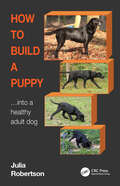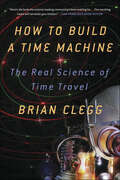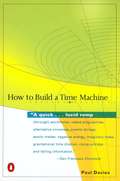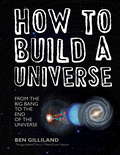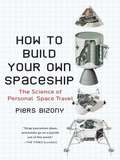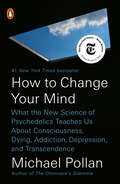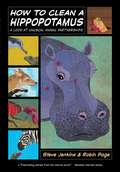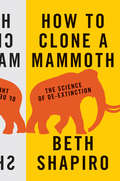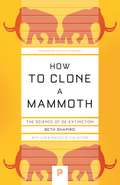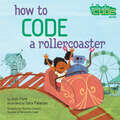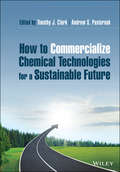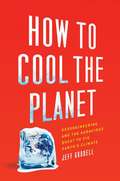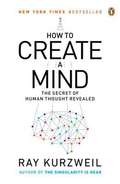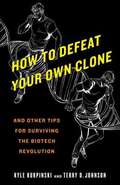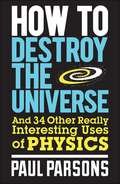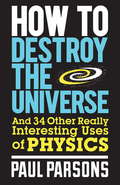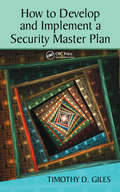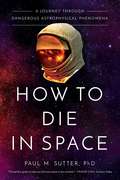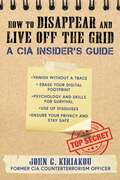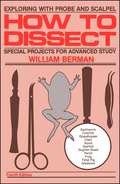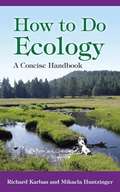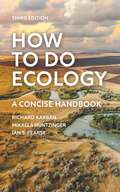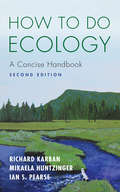- Table View
- List View
How to Build a Puppy: Into a Healthy Adult Dog
by Julia RobertsonDogs do not demonstrate discomfort or pain in a way that can be easily translated by us humans, so we often miss that they are physically struggling. Understanding that making some very simple changes to our homes, activities, exercise regimes and how we train our puppies will have a massive positive impact on our dogs' lives. Using her world-renowned Galen Myotherapy knowledge and approach, Robertson suggests and explains in detail how small, profoundly important but easy to implement changes can improve the way we not only look after and develop our puppies but also how maintenance of this easy programme continues your puppy’s journey through into healthy adolescence and maturity. Environment, exercise and activity habits have deep, ongoing effects and How to Build a Puppy ... into a healthy adult dog explores ways in which positive change can be integrated easily into our normal lives. The book culminates into a full programme called the Galen Myotherapy Puppy Physical Development Programme©. Including: A dedicated section on anatomy, explaining in a functional way how everything in the body interrelates to form a functional moving structure Practical advice that is made logical and easy to interpret by the use of clear comparative descriptions as well as clear diagrams and pictures showing the movement and biomechanics of dogs Exercises and activities in a practical programme, for all situations, that can be followed to help build good foundations A full pictorial explanation of why so many 'traditional' exercise routines and activities are in fact incredibly damaging for our dogs This book will help canine professionals better advise their clients, but also empower all readers to make their own changes, as well as having a better all-round understanding to enable more pertinent questions from their vet, breeder or puppy trainer.
How to Build a Time Machine: The Real Science of Time Travel
by Brian CleggThis look at time travel technology gives “a solid overview of some of the quirkier corners of physics, with an entertaining connection to pop culture” (Kirkus Reviews).In How to Build a Time Machine, physicist Brian Clegg provides an understanding of what time is and how it can be manipulated. He explores the fascinating speculations and the remarkable possibilities of real time travel that emerge from quantum entanglement, superluminal speeds, neutron star cylinders and wormholes in space. With the paradoxes of time travel echoing in our minds, will we realize that travel into the future might never be possible? Or will we realize there is no limit on what can be achieved, and take on this ultimate challenge? Only time will tell.“Dissects schemes such as going into the past and playing the stock market armed with foreknowledge of what will rise or fall. He covers most of the themes advanced by science fiction, plus some of the more adventurous scientific minds, generally avoiding math or tricky technical details.” —Kirkus Reviews“Explain[s] quantum entanglement and superluminal speeds in terms that even a technophobe could understand.” —Publishers Weekly“A genuinely intriguing book.” —Booklist“Clegg excels at making science accessible.” —Library Journal
How to Build a Time Machine
by Paul DaviesWith his unique knack for making cutting-edge theoretical science effortlessly accessible, world-renowned physicist Paul Davies now tackles an issue that has boggled minds for centuries: Is time travel possible? The answer, insists Davies, is definitely yes—once you iron out a few kinks in the space-time continuum. With tongue placed firmly in cheek, Davies explains the theoretical physics that make visiting the future and revisiting the past possible, then proceeds to lay out a four-stage process for assembling a time machine and making it work. Wildly inventive and theoretically sound, How to Build a Time Machine is creative science at its best—illuminating, entertaining, and thought provoking. .
How to Build a Universe: From the Big Bang to the End of the Universe
by Ben GillilandFrom the first particles of matter and atomic building-blocks to hydrogen fusion, large galaxies and supermassive black holes, with a healthy dose of history and fun facts to glue everything together, this is your very own guide to How to Build a Universe. Using a mixture of eye-catching graphics, humour and structured narrative, in How to Build a Universe, Metro columnist Ben Gilliland explains the complex concepts surrounding the birth and development of the galaxies, without overwhelming or patronising the reader. Gilliland demonstrates how the cosmos came to be - from the formation of the first particles in the Big Bang to the development of the first stars, galaxies, planets and leading up to the present day and where the future of the universe might lie. Each chapter has an ongoing narrative, building the universe piece by piece, with graphics and fact boxes interspersed throughout.
How to Build Your Own Spaceship
by Piers BizonyLadies and gentlemen, start your spaceships! Personal space travel is no longer the stuff of science fiction. The future is here: Civilians are launching into orbit. As early as 2010 paying customers will have the opportunity to experience weightlessness, courtesy of Virgin Galactic's inaugural launch. How to Build Your Own Spaceship takes readers on a fun and quirky trip to the forefront of commercial space travel-the latest technology, the major business players, and the personal and financial benefits that are ripe for the picking. Science-writer Piers Bizony's breadth of knowledge, quick wit, and no-nonsense explanations of the hard science in this emerging arena will satisfy even the most dedicated space fanatics. With practical advice (from picking the best jet fuel to funding your own fleet of space crafts), unbelievable space facts, and fascinating photos, Bizony's user-friendly guide to blasting off is a must-have ticket to the final frontier. .
How to Change Your Mind: What the New Science of Psychedelics Teaches Us About Consciousness, Dying, Addiction, Depression, and Transcendence
by Michael PollanNew York Times Book Review 10 Best Books of 2018A New York Times Notable Book The #1 New York Times bestseller.A brilliant and brave investigation into the medical and scientific revolution taking place around psychedelic drugs--and the spellbinding story of his own life-changing psychedelic experiences When Michael Pollan set out to research how LSD and psilocybin (the active ingredient in magic mushrooms) are being used to provide relief to people suffering from difficult-to-treat conditions such as depression, addiction and anxiety, he did not intend to write what is undoubtedly his most personal book. But upon discovering how these remarkable substances are improving the lives not only of the mentally ill but also of healthy people coming to grips with the challenges of everyday life, he decided to explore the landscape of the mind in the first person as well as the third. Thus began a singular adventure into various altered states of consciousness, along with a dive deep into both the latest brain science and the thriving underground community of psychedelic therapists. Pollan sifts the historical record to separate the truth about these mysterious drugs from the myths that have surrounded them since the 1960s, when a handful of psychedelic evangelists inadvertently catalyzed a powerful backlash against what was then a promising field of research.A unique and elegant blend of science, memoir, travel writing, history, and medicine, How to Change Your Mind is a triumph of participatory journalism. By turns dazzling and edifying, it is the gripping account of a journey to an exciting and unexpected new frontier in our understanding of the mind, the self, and our place in the world. The true subject of Pollan's "mental travelogue" is not just psychedelic drugs but also the eternal puzzle of human consciousness and how, in a world that offers us both suffering and joy, we can do our best to be fully present and find meaning in our lives.
How to Clean a Hippopotamus: A Look at Unusual Animal Partnerships
by Robin Page Steve JenkinsHow to Clean a Hippopotamus, a book about animal symbiosis, offers readers a close-up, step-by-step view of nature’s fascinating partnerships. Find out why a mongoose comes running when a warthog lies down, how a crab and an iguana help each other out, why ravens follow wolves, and more.
How to Clone a Mammoth
by Beth ShapiroCould extinct species, like mammoths and passenger pigeons, be brought back to life? The science says yes. In How to Clone a Mammoth, Beth Shapiro, evolutionary biologist and pioneer in "ancient DNA" research, walks readers through the astonishing and controversial process of de-extinction. From deciding which species should be restored, to sequencing their genomes, to anticipating how revived populations might be overseen in the wild, Shapiro vividly explores the extraordinary cutting-edge science that is being used--today--to resurrect the past. Journeying to far-flung Siberian locales in search of ice age bones and delving into her own research--as well as those of fellow experts such as Svante Pääbo, George Church, and Craig Venter--Shapiro considers de-extinction's practical benefits and ethical challenges. Would de-extinction change the way we live? Is this really cloning? What are the costs and risks? And what is the ultimate goal? Using DNA collected from remains as a genetic blueprint, scientists aim to engineer extinct traits--traits that evolved by natural selection over thousands of years--into living organisms. But rather than viewing de-extinction as a way to restore one particular species, Shapiro argues that the overarching goal should be the revitalization and stabilization of contemporary ecosystems. For example, elephants with genes modified to express mammoth traits could expand into the Arctic, re-establishing lost productivity to the tundra ecosystem. Looking at the very real and compelling science behind an idea once seen as science fiction, How to Clone a Mammoth demonstrates how de-extinction will redefine conservation's future.
How to Clone a Mammoth: The Science of De-Extinction (Princeton Science Library #108)
by Beth ShapiroAn insider's view on bringing extinct species back to lifeCould extinct species, like mammoths and passenger pigeons, be brought back to life? In How to Clone a Mammoth, Beth Shapiro, an evolutionary biologist and pioneer in ancient DNA research, addresses this intriguing question by walking readers through the astonishing and controversial process of de-extinction. From deciding which species should be restored to anticipating how revived populations might be overseen in the wild, Shapiro vividly explores the extraordinary cutting-edge science that is being used to resurrect the past. Considering de-extinction's practical benefits and ethical challenges, Shapiro argues that the overarching goal should be the revitalization and stabilization of contemporary ecosystems. Looking at the very real and compelling science behind an idea once seen as science fiction, How to Clone a Mammoth demonstrates how de-extinction will redefine conservation's future.
How to Code a Rollercoaster
by Josh FunkPearl and Pascal take their coding adventures to the amusement park in this follow-up picture book from our Girls Who Code program!Pearl and her trusty rust-proof robot, Pascal, are enjoying a day out at the amusement park. Spinning teacups, ice cream, and of course: rollercoasters! Through the use of code, Pearl and Pascal can keep track of their ride tokens and calculate when the line is short enough to get a spot on the biggest ride of them all--the Python Coaster. Variables, if-then-else sequences, and a hunt for a secret hidden code make this a humorous, code-tastic day at the amusement park!
How to Commercialize Chemical Technologies for a Sustainable Future
by Timothy J. ClarkThe definitive guide for scientific entrepreneurs commercializing sustainable technologies in the chemical sector Lacking the considerable resources of multinational chemical companies, entrepreneurs face a unique set of risks and challenges. How to Commercialize Chemical Technologies for a Sustainable Future is targeted at innovators who are embarking on the entrepreneurial path with their sustainable chemical technology but are unsure of what steps to take. This first-of-its-kind resource features contributions from a diverse team of expert authors, including engineers, venture capitalists, marketing specialists, intellectual property professionals, regulatory experts, industry practitioners, and many others. Accessible and highly practical, this real-world guide covers each step of the technology commercialization process, from market landscape analysis and financing to scale-up and strategic partnering. Throughout the book, effective tactics and strategies for growing a new venture are supported by case studies highlighting the economic and environmental impact of successful commercialization, and identifying the common mistakes that lead to lost opportunities. Filled with invaluable advice and actionable steps, this book: Uses valuation concepts, tools, and examples to demonstrate that for a chemical technology to be sustainable it must not only have market value but also confer benefits to human well-being and the environment Offers templates and tools for understanding what customers need, who the competition is and how to successfully differentiate your product to those customers Describes how to practically advance your technology from conception all the way to commercial demonstration Presents advantages and disadvantages of strategic partnering from the perspective of the start-up and the larger industrial partner, along with strategies to mitigate risks within a partnership Provides an overview of the legal regulatory requirements for bringing new chemicals to market in several key geographic regions, as well as the impact of public policy on commercialization Offers insights and practical strategies on intellectual property management, raising investment, and operationalizing a startup company How to Commercialize Chemical Technologies for a Sustainable Future is essential reading for budding entrepreneurs in chemistry, materials science, and chemical engineering looking to bring their sustainable technologies to market. It is also a valuable reference for investors, policymakers, regulators, and other professionals.
How to Cool the Planet: Geoengineering and the Audacious Quest to Fix Earth's Climate
by Jeff GoodellWhen Jeff Goodell first encountered the term "geoengineering," he had a vague sense that it involved outlandish schemes to counteract global warming. As a journalist, he was deeply skeptical. But he was also intrigued. The planet was in trouble. Could geoengineers help? Climate change may well be the biggest crisis humanity has ever faced. Temperatures in some regions of the world could increase by as much as fifteen degrees by the end of the century, causing rising sea levels and severe droughts. But change could also happen much more suddenly. What if we had a real climate emergency, the ecological equivalent of the subprime mortgage meltdown -- how could we cool the planet in a hurry? As Goodell shows in this bracing book, even if we could muster the political will for it, cutting greenhouse gas emissions alone may not be enough to reduce the risk of climate catastrophe. This has led some scientists to pursue extreme solutions: huge contraptions that would suck CO2 from the air, machines that would brighten clouds and deflect sunlight away from the earth, even artificial volcanoes that would spray heat-reflecting particles into the atmosphere. In How to Cool the Planet, Goodell explores the scientific, political, financial, and moral aspects of geoengineering. How are we to change the temperature of whole regions if we can't even predict next week's weather? What if a wealthy entrepreneur shoots particles into the stratosphere on his own? What about wars waged with climate control as the primary weapon? What happens to our relationship with nature when, as Goodell puts it, we all find ourselves living in a giant terrarium? And our options are dwindling. Maybe, Goodell suggests, we need to start taking geoengineering seriously. Maybe it's Plan B for the planet. And if it is, we need to know enough to get it right. Thoroughly reported and convincingly argued, How to Cool the Planet is a compelling tale of scientific hubris and technical daring. But it is also a thoughtful, even-handed look at a deeply complex and controversial issue. It's a book that will surely jump-start the next big debate about the future of life on earth.
How to Create a Mind: The Secret of Human Thought Revealed
by Ray KurzweilThe bold futurist and bestselling author explores the limitless potential of reverse-engineering the human brainRay Kurzweil is arguably today’s most influential—and often controversial—futurist. In How to Create a Mind, Kurzweil presents a provocative exploration of the most important project in human-machine civilization—reverse engineering the brain to understand precisely how it works and using that knowledge to create even more intelligent machines.Kurzweil discusses how the brain functions, how the mind emerges from the brain, and the implications of vastly increasing the powers of our intelligence in addressing the world’s problems. He thoughtfully examines emotional and moral intelligence and the origins of consciousness and envisions the radical possibilities of our merging with the intelligent technology we are creating.Certain to be one of the most widely discussed and debated science books of the year, How to Create a Mind is sure to take its place alongside Kurzweil’s previous classics which include Fantastic Voyage: Live Long Enough to Live Forever and The Age of Spiritual Machines.From the Hardcover edition.
How to Create a Mind: The Secret of Human Thought Revealed
by Ray KurzweilThe bestselling author of The Singularity Is Near explores the limitless potential of reverse-engineering the human brain Ray Kurzweil is arguably today's most influential futurist. In How to Create a Mind, he presents a provocative exploration of the most important project in the human-machine civilization: reverse-engineering the brain to understand precisely how it functions and using that knowledge to create even more intelligent machines. Kurzweil discusses how the brain works, how the mind emerges, brain-computer interfaces, and the implications of vastly increasing the powers of our intelligence to address the world's problems. Certain to be one of the most widely discussed and debated science books of the year, How to Create a Mind is sure to take its place alongside Kurzweil's previous classics.
How to Defeat Your Own Clone: And Other Tips for Surviving the Biotech Revolution
by Kyle Kurpinski Terry D. JohnsonSend in the clones! On second thought, maybe not. CAN IT READ MY MIND? WILL IT BE EVIL? HOW DO I STOP IT? Find out the answers to these and other burning questions in this funny, informative, and ingenious book from two bioengineering experts who show you how to survive—and thrive—in a new age of truly weird science. For decades, science fiction has been alerting us to the wonders and perils of our biotech future—from the prospects of gene therapy to the pitfalls of biological warfare. Now that future looms before us. Don’t panic! This book is all you need to prepare for the new world that awaits us, providing indispensable cautionary advice on topics such as • bioenhancements: They’re not just for cyborgs anymore. • DNA sequencing and fingerprinting: What’s scarier than the government having your DNA on file? Try having it posted on the Internet. • human cloning: Just like you, only stronger, smarter, and more attractive. In other words: more dangerous. Our future may be populated by designer babies, genetically enhanced supersoldiers, and one (or more!) of your genetic duplicates, but all is not lost. How to Defeat Your Own Clone is the ultimate survival guide to what lies ahead. Just remember the first rule of engagement: Don’t ever let your clone read this book!
How to Destroy the Universe
by Paul ParsonsIf you thought physics was all about measuring the temperature of ice in a bucket or trying to fathom what E=mc2 means, think again. How to Destroy the Universe and 34 other really interesting uses of physics demystifies the astonishing world of physics in a series of intriguing, entertaining and often extraordinary scenarios--that explain key physics concepts in plain and simple language.You'll find out how to save the planet from energy shortages by mining the vacuum of empty space, engineer the Earth's climate to reverse the effects of global warming, and fend off killer asteroids just like Bruce Willis and his vest. You'll learn essential survival skills such as how to live through a lightning strike, how to tough it out during an earthquake and how to fall into a black hole without being squashed into spaghetti. And you'll discover some plain old cool stuff like how to turn lead into gold, how to travel to the centre of the Earth, how to crack supposedly unbreakable codes and how to use physics to predict the stock market.So if you want to get to grips with science behind relativity, antigravity and parallel universes, or if you are really more interested in learning how to teleport, travel through time or achieve immortality, this is the perfect introduction to the amazing world of modern physics.
How to Destroy the Universe: And 34 other really interesting uses of physics
by Paul ParsonsHow to survive an earthquake. How to make an invisibility cloak. How to turn lead into gold. How to read someone's mind. Physics = tedious and unfathomable, right? No longer. If you thought physics was all about measuring the temperature of an ice bucket or trying to understand complicated equations, think again. How to Destroy the Universe will make you see the world around us through fresh eyes.
How to Destroy the Universe: And 34 other really interesting uses of physics
by Paul ParsonsHow to survive an earthquake. How to make an invisibility cloak. How to turn lead into gold. How to read someone's mind. Physics = tedious and unfathomable, right? No longer. If you thought physics was all about measuring the temperature of an ice bucket or trying to understand complicated equations, think again. How to Destroy the Universe will make you see the world around us through fresh eyes.
How to Develop and Implement a Security Master Plan
by Timothy GilesWritten for corporation security officers, this work is designed to help them garner executive support and increased funding for their security programs. It provides a thorough examination of the Security Master Planning process, explaining how to develop appropriate risk mitigation strategies and how to focus on both effectiveness and efficiency while conducting a site security assessment. The author constructs a comprehensive five-year plan that is synchronized with the strategies of a business or institution. This is a valuable reference tool for security professionals of small and large corporations, as well as for consultants in the field.
How to Die in Space: A Journey Through Dangerous Astrophysical Phenomena
by Paul SutterA brilliant and breathtakingly vivid tour of the universe, describing the physics of the dangerous, the deadly, and the scary in the cosmos.So you&’ve fallen in love with space and now you want to see it for yourself, huh? You want to witness the birth of a star, or visit the black hole at the center of our galaxy? You want to know if there are aliens out there, or how to travel through a wormhole? You want the wonders of the universe revealed before your very eyes? Well stop, because all that will probably kill you. From mundane comets in our solar backyard to exotic remnants of the Big Bang, from dying stars to young galaxies, the universe may be beautiful, but it&’s treacherous. Through metaphors and straightforward language, it breathes life into astrophysics, unveiling how particles and forces and fields interplay to create the drama in the heavens above us.
How to Disappear and Live Off the Grid: A CIA Insider's Guide
by John KiriakouWith an experienced CIA officer as your teacher, you&’ll gain the knowledge and necessary tools to protect yourself and the ones you love.No matter where we go, we leave tracks and clues of our existence without even knowing. Our electronic footprint becomes our invisible trail. In this day in age where the world seems to be at our fingertips and social media plays a huge role in our daily lives, it&’s hard not to leave part of our digital selves for others to find.Whether you&’re fascinated by the idea of disappearing, want to erase your digital footprint, or simply concerned about your safety and privacy, knowing how to become invisible is a survival skill that will come in handy.Through the easy-to-follow instructions, tips, tricks, and professional anecdotes in How to Disappear and Live off the Grid: A CIA Insider's Guide, you&’ll learn to vanish without a trace from John Kiriakou, a former CIA counterterrorism officer and senior investigator for the Senate Foreign Relations Committee responsible for the capture of Abu Zubaydah.
How to Do Ecology
by Mikaela Huntzinger Richard KarbanMost ecology books and courses focus on the facts and the concepts. While these are essential, many young ecologists need to figure out how to actually do research themselves. How to Do Ecology provides nuts-and-bolts advice on how to develop a successful thesis and research program. This book presents different approaches to posing testable ecological questions. In particular, it covers the uses, strengths, and limitations of manipulative experiments in ecology. It will help young ecologists consider meaningful treatments, controls, replication, independence, and randomization in experiments, as well as where to do experiments and how to organize a season of work. This book also presents strategies for analyzing natural patterns, the value of alternative hypotheses, and what to do with negative results.Science is only part of being a successful ecologist. This engagingly written book offers students advice on working with other people and navigating their way through the land mines of research. Findings that don't get communicated are of little value. How to Do Ecology suggests effective ways to communicate information in the form of journal articles, oral presentations, and posters. Finally, it outlines strategies for developing successful grant and research proposals. Numerous checklists, figures, and boxes throughout the book summarize and reinforce the main points. In short, this book makes explicit many of the unspoken assumptions behind doing good research in ecology, and provides an invaluable resource for meaningful conversations among ecologists.
How to Do Ecology: A Concise Handbook - Third Edition
by Mikaela Huntzinger Richard Karban Ian S. PearseThe essential insider’s guide for ecologists at all career stages—now completely updated and expandedMost books and courses in ecology focus on facts and concepts but do little to explain the process of research. How to Do Ecology provides nuts-and-bolts advice for organizing and conducting a successful research program. This fully updated and expanded edition explains how to ask and answer your own research questions using compelling study design and appropriate stats. Ecology doesn’t take place exclusively outdoors, so the book shares invaluable insights on topics such as identifying your goals, developing professional relationships, reading efficiently, and organizing a field season. Because the currency in ecology is publications, it also suggests effective ways to communicate your ideas through journal articles, oral presentations, posters, and grant proposals. This incisive handbook makes explicit many of the unstated rules that ecologists follow and serves as a practical resource for meaningful conversations about ecology.This new edition includes:Expanded emphasis on collecting and interpreting observational dataAn innovative new workshop for generating and evaluating creative research questionsHelpful tips on developing the skills most important to students, navigating your career path, writing efficiently, and more
How to Do Ecology
by Richard Karban Ian S. Pearse Mikaela HuntzingerMost books and courses in ecology cover facts and concepts but don't explain how to actually do ecological research. How to Do Ecology provides nuts-and-bolts advice on organizing and conducting a successful research program. This one-of-a-kind book explains how to choose a research question and answer it through manipulative experiments and systematic observations. Because science is a social endeavor, the book provides strategies for working with other people, including professors and collaborators. It suggests effective ways to communicate your findings in the form of journal articles, oral presentations, posters, and grant and research proposals. The book also includes ideas to help you identify your goals, organize a season of fieldwork, and deal with negative results. In short, it makes explicit many of the unspoken assumptions behind doing good research in ecology and provides an invaluable resource for meaningful conversations between ecologists.This second edition of How to Do Ecology features new sections on conducting and analyzing observational surveys, job hunting, and becoming a more creative researcher, as well as updated sections on statistical analyses.
